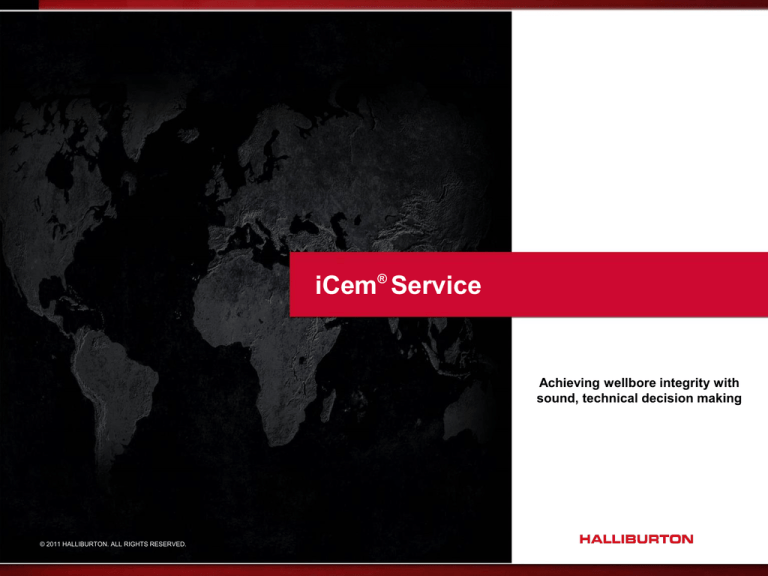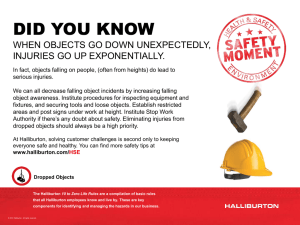
iCem® Service
Achieving wellbore integrity with
sound, technical decision making
© 2011 HALLIBURTON. ALL RIGHTS RESERVED.
Increasing the Probability of Wellbore Integrity
Sound technical decisions rely on:
– Field-proven technical solutions
– Laboratory-driven empirical data
And now the most robust cementing design tool
available in the industry:
iCem® Service
Drive better decisions by collaboratively conducting
iterative scenarios and evaluating alternatives for
achieving successful cementing operations.
© 2011 HALLIBURTON. ALL RIGHTS RESERVED.
iCem® Service – Wellbore Integrity
Water Aquifer
Increasing the probability of
a successful cementing job
• Restrict fluid
movement between
formations
• Bond and support
the casing
Hydrocarbon Zone
Hydrocarbon Zone
© 2011 HALLIBURTON. ALL RIGHTS RESERVED.
iCem® Service – Analysis for the Life of the Well
Drilling
Completion
Production
BENEFITS OF LIFE-OF-THE-WELL CEMENTING
Long-Term Zonal Isolation
Help Increase Production and Minimize the Occurrence of Sustained Casing Pressure
Help Minimize Remedial Costs
Help Minimize Environmental Impact
© 2011 HALLIBURTON. ALL RIGHTS RESERVED.
General Cementing Job – Process Overview
Solution Development
Finite Element
Analysis
Computational Fluid
Dynamics
Job Execution
Density Control
High-Capacity Blender
Dropping the Plug
Bulk Delivery and Feed
Cement Sheath with optimum zonal isolation
is the objective for each individual well.
© 2011 HALLIBURTON. ALL RIGHTS RESERVED.
Results Evaluation
Bump the Plug
Cement Bond Log
iCem® Service – Process Overview
Solution Development
Well Configuration
Formation Properties
Casing Properties
Operational Loads
Mud, Spacer, Cement
Fluid Properties
Job Execution
Real-Time Data
ECD (calculated)
Fluid Volumes &
Densities
Pump Rates
Planned vs Actual
Job Comparison
High-Level Features
Fresh User Interface
Dynamic Temperature
PROFILE™ Wellbore
Modeling with Heat
Schematic with
Transfer and Slurry
Directional View
Placement Temperature
Graph
2D Hydraulics Simulator
Real-time Data
3D Fluid Displacement
Acquisition
Simulator
and Monitoring
Stress Analysis Simulator
© 2011 HALLIBURTON. ALL RIGHTS RESERVED.
Results Evaluation
Future Design
Optimization
Analysis of ECDs, Fluid
Volumes, Fluid Density,
Pump Rates, etc.
Legacy Discrete Software Now Consolidated
OptiCem™ Software
Cement Job Simulation
Finite Element Analysis
Displace 3D® Simulator
Displacement models in 3D
Computational Fluid Dynamics
WellLife® Express Service
Cement Sheath Stress Analysis
Finite Element Analysis
Data Acquisition
Field data acquisition and monitoring
© 2011 HALLIBURTON. ALL RIGHTS RESERVED.
iCem
®
Service
iCem® Service
© 2011 HALLIBURTON. ALL RIGHTS RESERVED.
Two-Dimensional Hydraulic Simulation
Equivalent circulating density (ECD) management
Dynamic temperature affects on fluid properties
Pump schedule design
– With and without foam cement
– Volume to achieve TOC
Balanced plug
Standoff
Torque and drag
Surge and swab
Mud removal and erodibility
Advanced rheological modeling
Other utilities (i.e. integrated fluid-flow potential)
Complex wellbore geometry designs
Automatic pump rate adjustment to stay below fracture gradient
© 2011 HALLIBURTON. ALL RIGHTS RESERVED.
Two-Dimensional Hydraulics Simulation
Interactive temperature
profile graph
– Casing temperature
– Annular temperature
profiles
– Bottomhole
circulating
temperature
© 2011 HALLIBURTON. ALL RIGHTS RESERVED.
Two-Dimensional Hydraulics Simulation
Cement stages
temperature tracker
© 2011 HALLIBURTON. ALL RIGHTS RESERVED.
Three-Dimensional Displacement Simulator
Fluid interface
Fluid placement over time at all depths
– Drilling fluid
– Spacer
– Lead cement
– Tail cement
Helps determine spacer volume to
avoid contamination of cement
© 2011 HALLIBURTON. ALL RIGHTS RESERVED.
Three-Dimensional Displacement Simulator
Conforms to highly eccentric
annuli or localized washout
Predict Material Volumes to
– Avoid contamination
– Achieve top of cement (TOC)
© 2011 HALLIBURTON. ALL RIGHTS RESERVED.
Achieve optimum casing standoff
Determine impact of pump rate
Determine impact of pipe rotation
and reciprocation
Three-Dimensional Displacement Simulator
The same data can
be represented both
in a graph (above)
or a cross section
of the well (below)
Helps determine a
volume of spacer
for optimized
displacement.
70%
10%
Direct correlation
of data.
In this example further
iterations are required
to develop a design
that eliminates
channeling.
© 2011 HALLIBURTON. ALL RIGHTS RESERVED.
Cement Sheath Stress Analysis
Examines Effects of Planned Well Operations on Specific Cement Designs
Cement hydration
Shoe pressure testing
Fracturing / stimulation
Completion fluid change
out
Injection and production
Evacuation / unloading
Well kill
© 2011 HALLIBURTON. ALL RIGHTS RESERVED.
Cement Sheath Stress Analysis
Predicts the competence of a cement sheath
Generates mechanical properties for the sheath to
survive downhole stress conditions
Simulator elements
– Properties of the formation
– Well structure
– Long-term critical well conditions
Operation Type
Product
TVD
(ft)
(ft)
166880
Casing Fluid Pressure
(psi)
Pre-Job Temperature
(°F)
166880
Casing Fluid Temperature
(°F)
11409.0
© 2011 HALLIBURTON. ALL RIGHTS RESERVED.
MD
141.0
Pore Pressure
(psi)
416.0
11076.0
Cement Sheath Stress Analysis – “What If?”
Reports on performance
differing cement systems allowing
cost analysis
Enables decisions based
comparisons of cementing
mechanical properties
–
–
–
–
–
–
–
–
Young’s Modulus
Poisson’s Ratio
Shrinkage
Thermal expansion
Compressive strength
Tensile strength
Thermal conductivity
Specific heat
© 2011 HALLIBURTON. ALL RIGHTS RESERVED.
Real-Time Data Acquisition and Monitoring
Real-time collection and graphing of cementing operations data
– Equivalent circulating densities (ECDs)
– Pump pressure
– Pump rate
– Fluid volume
– Fluid density
– Scores
© 2011 HALLIBURTON. ALL RIGHTS RESERVED.
Real-Time Data Acquisition and Monitoring
Evaluation of pre-job simulations against
recorded job data – During or after the job
– Identification of probable causes of irregularities
on the job
– Enables optimization of future designs
© 2011 HALLIBURTON. ALL RIGHTS RESERVED.
Case History – Field Application
Challenge (Libya)
– Poor cement bond log (CBL) results
from first two production wells in a
new field
Solution
– Three-dimensional displacement
Simulation and cement sheath stress
analysis
• Modified mud rheology
• Increased use of centralizers to
achieve 70% standoff
• Increased spacer volume to 60
bbl
Result
– Significantly improved CBLs in wells
after optimized plan via
iCem® service
© 2011 HALLIBURTON. ALL RIGHTS RESERVED.
Poor CBL from
previous wells
Excellent CBL after simulations
designed solution modifications
Case History – Field Application
Challenge (Shale North America)
– Highly stressed formation subjecting
wells to excessive washout, sloughing
shales, stuck pipe, and poor cement
jobs
Solution – iCem® service simulation
revealed risks of debonding and causes of
sheath failure over time due to wellbore
stresses and led to changes as follows:
– Wellbore fluid conditioning
– Optimized centralizer placement for
proper standoff
– Cement spacer properties
– Resilient mechanical properties
designed into the slurry to address
completion and production wellbore
stresses to the cement sheath
Result
– CBL indicated dramatic improvements
in placement coverage over
conventional cements used previously
– Previously required remediation was
avoided
© 2011 HALLIBURTON. ALL RIGHTS RESERVED.
Case History – Field Application
Challenge (HPHT)
– High profile eastern-hemisphere wells for a
major operator in a field where previous wells
experienced
• Gas migration and channeling issues
• Expense and delay of remedial
cementing operations
Solution – Eight (8) iCem® service simulations run
during a 2-hour meeting evaluating the following
parameters
– Spacer volume
– Wiper plugs
– Rotation and reciprocation during pumping
operations
– Pump rates
– Centralization
Result
– Spacer volume doubled over previous well
plans
– Pump rates increased though still within
fracture gradient limits
– Centralizers changed to ones that allow pipe
rotation
– Cement bond logs were excellent / no
remediation required
© 2011 HALLIBURTON. ALL RIGHTS RESERVED.
Summary
Job Plan
Slurry
Design
Surge &
Swab
Avoidance
Cement
Mechanical
Properties
Centralizer
Selection
iCem®
Cement
Sheath
Analysis
Service
Torque &
Drag
Minimization
Achieve Topof-Cement
ECD
Management
Mud
Conditioning
Avoid Cement
Contamination
© 2011 HALLIBURTON. ALL RIGHTS RESERVED.
Casing
Placement
Displacement
Efficiency
iCem® Service
Questions?
© 2011 HALLIBURTON. ALL RIGHTS RESERVED.








